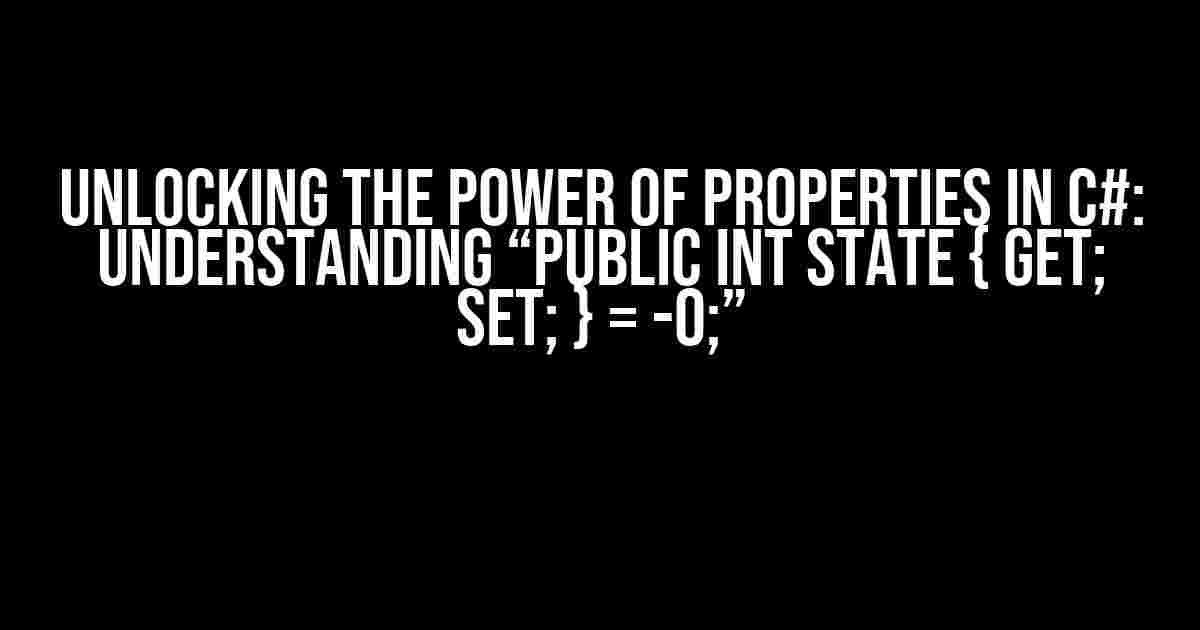Introduction
In the world of C# programming, properties play a vital role in controlling access to an object’s members. One of the most common and versatile property declarations is the auto-implemented property, which can be represented by the syntax “public int State { get; set; } = -0;”. But what does this syntax mean, and how can you effectively utilize it in your programming endeavors? In this article, we’ll delve into the world of auto-implemented properties, explore their benefits, and provide step-by-step guidance on how to use them to elevate your coding skills.
The Basics of Auto-Implemented Properties
Before diving into the specifics of “public int State { get; set; } = -0;”, let’s first understand the concept of auto-implemented properties in C#. An auto-implemented property is a property that is automatically implemented by the compiler, eliminating the need for a private field and traditional get and set accessor methods. This simplifies the coding process and reduces the amount of code required to declare and manage properties.
Benefits of Auto-Implemented Properties
Auto-implemented properties offer several benefits, including:
- Concise syntax**: Auto-implemented properties require minimal code, making your codebase more readable and maintainable.
- Encapsulation**: Properties provide a layer of abstraction, controlling access to an object’s members and ensuring data integrity.
- Flexibility**: Auto-implemented properties can be used to implement a wide range of scenarios, from simple data storage to complex business logic.
Breaking Down “public int State { get; set; } = -0;”
Now that we’ve covered the basics of auto-implemented properties, let’s dissect the syntax “public int State { get; set; } = -0;”.
public int State { get; set; } = -0;Access Modifier: public
The first part of the syntax, “public”, specifies the access level of the property. In this case, the property is declared as public, meaning it can be accessed from any part of the program.
Property Type: int
The second part, “int”, specifies the data type of the property. In this case, the property is of type integer, which means it can hold integer values.
Property Name: State
The third part, “State”, is the name of the property. This is the identifier used to access the property.
Get and Set Accessors
The “{ get; set; }” part of the syntax declares the get and set accessors for the property. The get accessor is used to retrieve the value of the property, while the set accessor is used to set the value of the property.
Initializer: = -0
The “= -0” part of the syntax initializes the property with a default value of -0. This means that when an instance of the class is created, the State property will be set to -0 by default.
Using “public int State { get; set; } = -0;” in Practice
Now that we’ve broken down the syntax, let’s explore how to use “public int State { get; set; } = -0;” in a real-world scenario.
Example: Implementing a Simple State Machine
Suppose we’re building a simple state machine that can be in one of three states: Idle, Running, or Paused. We can use the “public int State { get; set; } = -0;” syntax to implement this state machine.
public class StateMachine
{
public int State { get; set; } = -0;
public void Start()
{
State = 1; // Set state to Running
}
public void Pause()
{
State = 2; // Set state to Paused
}
public void Resume()
{
State = 1; // Set state to Running
}
public void Stop()
{
State = 0; // Set state to Idle
}
}
In this example, we’ve declared a StateMachine class with a public int property called State, which is initialized to -0 by default. The Start, Pause, Resume, and Stop methods manipulate the State property to transition the state machine between different states.
Tips and Best Practices
When using “public int State { get; set; } = -0;”, keep the following tips and best practices in mind:
Use Meaningful Names
Choose meaningful names for your properties to improve code readability and maintainability.
public int NumberOfAttempts { get; set; } = 0;Use Appropriate Access Modifiers
Use appropriate access modifiers (public, private, protected, internal) to control access to your properties.
private int passwordHash { get; set; }Initialize Properties Wisely
Initialize properties wisely to avoid unexpected behavior or data corruption.
public int Balance { get; set; } = 0.0m;Conclusion
In conclusion, “public int State { get; set; } = -0;” is a powerful syntax that simplifies property declaration and management in C#. By understanding the basics of auto-implemented properties and how to use this syntax effectively, you can write more concise, readable, and maintainable code. Remember to follow best practices and use meaningful names, appropriate access modifiers, and wise initialization to get the most out of your properties.
| Property Syntax | Explanation |
|---|---|
| public int State { get; set; } | Declares a public integer property with get and set accessors. |
| public int State { get; set; } = -0 | Declares a public integer property with get and set accessors and initializes it to -0. |
By mastering the art of property declaration and management, you’ll be well on your way to becoming a proficient C# developer.Here are the 5 Questions and Answers about “public int State { get; set; } = -0;”:
Frequently Asked Questions
Welcome to our FAQ section, where we dive into the mysteries of C# programming!
What does the “public int State” part mean?
The “public int State” part declares a public property named “State” of type integer (int). The “public” access modifier means that this property can be accessed from anywhere in the program.
What’s the deal with the “{ get; set; }” part?
The “{ get; set; }” part is called an auto-implemented property. It’s a shorthand way to create a property with a private field that can be gotten and set. Think of it like a magical box that stores a value, and you can access that value using the “get” and “set” keywords.
What’s the purpose of the “= -0” part?
The “= -0” part is the default value assigned to the “State” property. In this case, it’s setting the initial value to -0, which is an interesting choice. Note that -0 is not the same as 0; it’s a special value that represents negative zero. (Spoiler alert: it’s rarely used in practice, but it’s fun to know it exists!)
Can I change the value of “State” later in the program?
Yes, you can! Since the property has a public setter, you can change the value of “State” at any time using the “set” keyword. For example, you could do something like “myObject.State = 42” to set the value to 42. Just be careful not to set it to a value that would cause chaos in your program!
Is this code snippet commonly used in real-world applications?
Honestly, no. This code snippet is a bit unusual, especially the use of -0 as the default value. But hey, it’s a great conversation starter, and it’s always fun to explore the weird and wonderful world of C# programming!



